The Influence of Steel Fiber Tensile Strengths and Aspect Ratios on the Fracture Properties of High-Strength Concrete
Abstract
1. Introduction
2. Experimental Program
2.1. Material Preparation and Fabrication
2.2. Test Set-Up
3. Results and Discussion
3.1. Flexural Stress CMOD Curves for SFRC Specimens
3.2. Evaluation of Residual Flexural Strength of SFRC
3.3. Determination of Fracture Energy of SFRC
4. Conclusions
Author Contributions
Funding
Conflicts of Interest
References
- Almusallam, T.; Ibrahim, S.; Al-Salloum, Y.; Abadel, A.; Abbas, H. Analytical and experimental investigations on the fracture behavior of hybrid fiber reinforced concrete. Cem. Concr. Compos. 2016, 74, 201–217. [Google Scholar] [CrossRef]
- Lee, J.-H. Influence of concrete strength combined with fiber content in the residual flexural strengths of fiber reinforced concrete. Compos. Struct. 2017, 168, 216–225. [Google Scholar] [CrossRef]
- Yoo, D.-Y.; Yoon, Y.-S.; Banthia, N. Flexural response of steel-fiber-reinforced concrete beams: Effects of strength, fiber content, and strain-rate. Cem. Concr. Compos. 2015, 64, 84–92. [Google Scholar] [CrossRef]
- Koh, K.T.; Kang, S.T.; Park, J.J.; Ryu, G.S. A Study on the Improvement of WorkabiIity of High Strength SteeI Fiber Reinforced Cementitious Composites. J. Korea Inst. Struct. Maint. Insp. 2014, 8, 141–148. (In Korean) [Google Scholar]
- Caggiano, A.; Folino, P.; Lima, C.; Martinelli, E.; Pepe, M. On the mechanical response of Hybrid Fiber Reinforced Concrete with Recycled and Industrial Steel Fibers. Constr. Build. Mater. 2017, 147, 286–295. [Google Scholar] [CrossRef]
- Gao, J.; Sun, W.; Morino, K. Mechanical properties of steel fiber-reinforced, high-strength, lightweight concrete. Cem. Concr. Compos. 1997, 19, 307–313. [Google Scholar] [CrossRef]
- Yazıcı, Ş.; Inan, G.; Tabak, V. Effect of aspect ratio and volume fraction of steel fiber on the mechanical properties of SFRC. Constr. Build. Mater. 2007, 21, 1250–1253. [Google Scholar]
- Koksal, F.; Altun, F.; Yiğit, I.; Şahin, Y.; Yiğit, I. Combined effect of silica fume and steel fiber on the mechanical properties of high strength concretes. Constr. Build. Mater. 2008, 22, 1874–1880. [Google Scholar] [CrossRef]
- Köksal, F.; Sahin, Y.; Sahin, M. Effect of Steel Fiber Tensile Strength on Mechanical Properties of Steel Fiber Reinforced Concretes. ACI SP 2012, 289, 129–143. [Google Scholar]
- Jang, S.J.; Yun, H.D. Effects of Curing Age and Fiber Volume Fraction on Flexural Behavior of High-Strength Steel Fiber-Reinforced Concrete. J. Korean Soc. Hazard Mitig. 2016, 16, 15–21. (in Korean). [Google Scholar] [CrossRef]
- Soroushian, P.; Bayasi, Z. Fiber type effects on the performance of steel fiber reinforced concrete. Mater. J. 1991, 88, 129–134. [Google Scholar]
- EN 14651. Test Method for Metallic Fibered Concrete–Measuring the Flexural Tensile Strength (Limit of Proportionality (LOP), Residual). 2005. Available online: http://auber.com.vn/upload/download/445669281373.pdf (accessed on 29 June 2019).
- Du Béton, F.I. Model Code 2010—First Complete Draft. fib Bulletin, (55), 318. 2010. Available online: https://www.fib-international.org/publications/fib-bulletins/model-code-2010-first-complete-draft,-vol-1-pdf-146-detail.html (accessed on 29 June 2019).
- JCI-S-001-2003. Method of Test for Fracture Energy of Concrete by Use of Notched Beam. 2003. Available online: http://www.jci-net.or.jp/j/jci/study/jci_standard/JCI-S-001-2003-e.pdf (accessed on 29 June 2019).
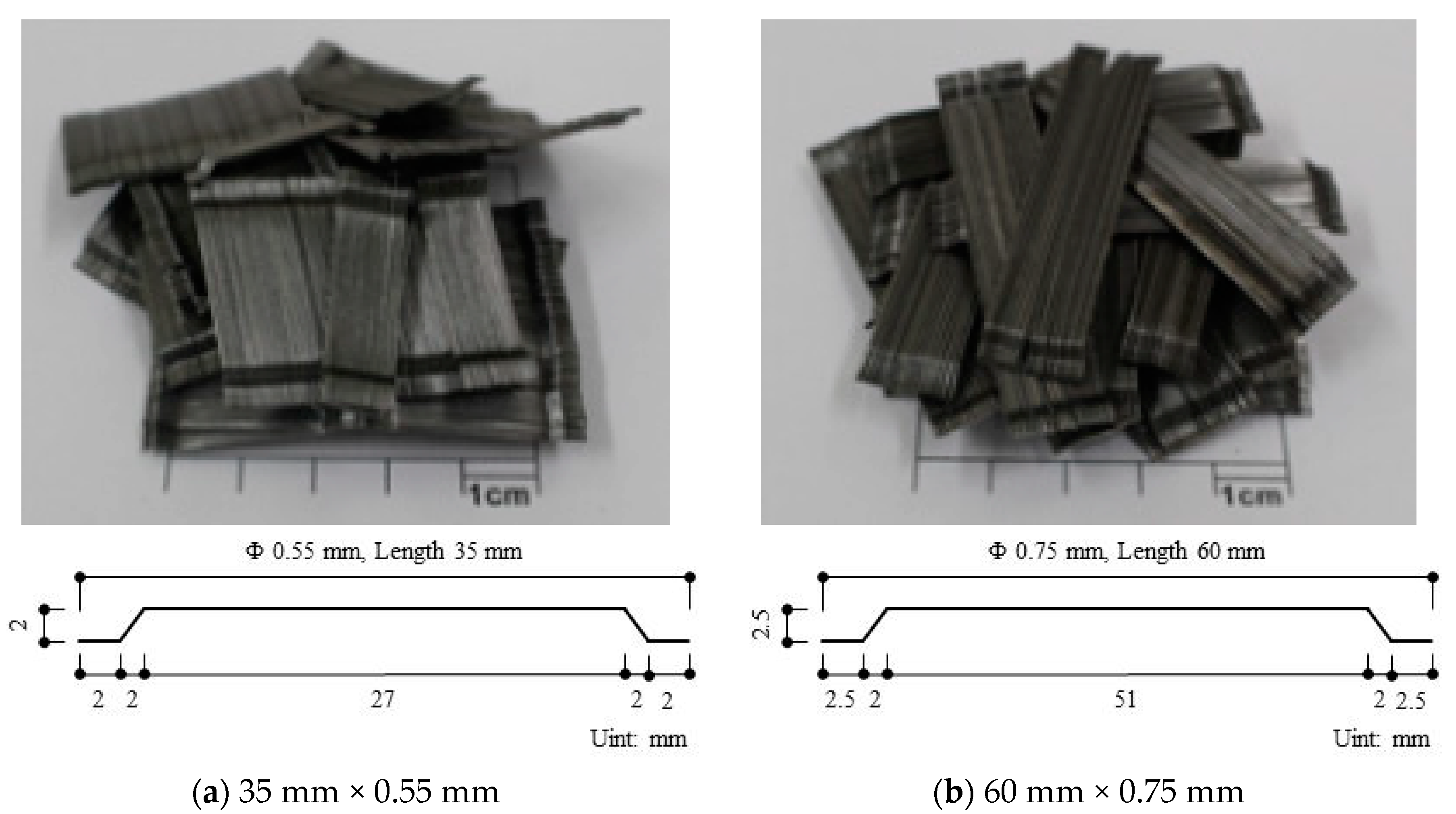

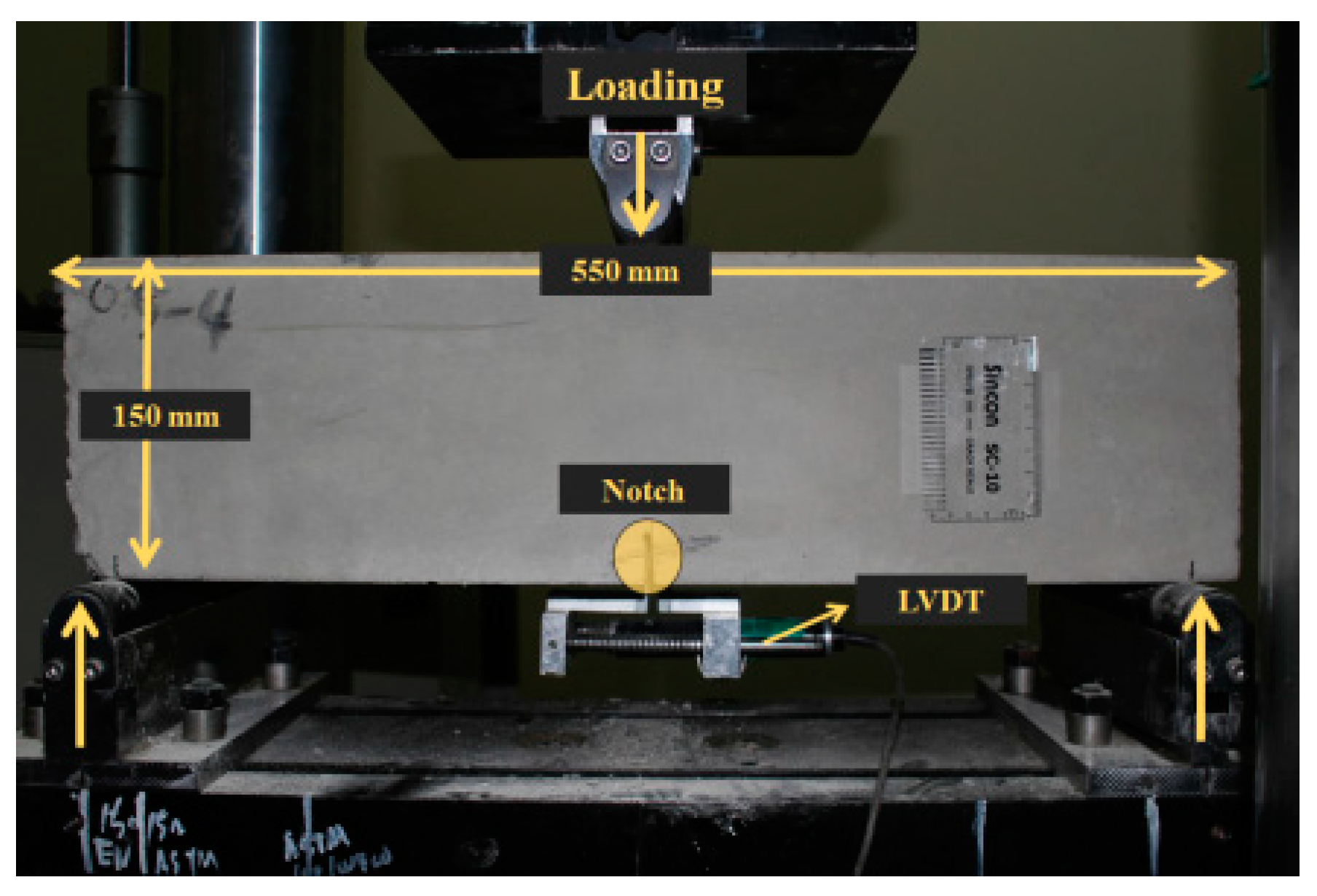
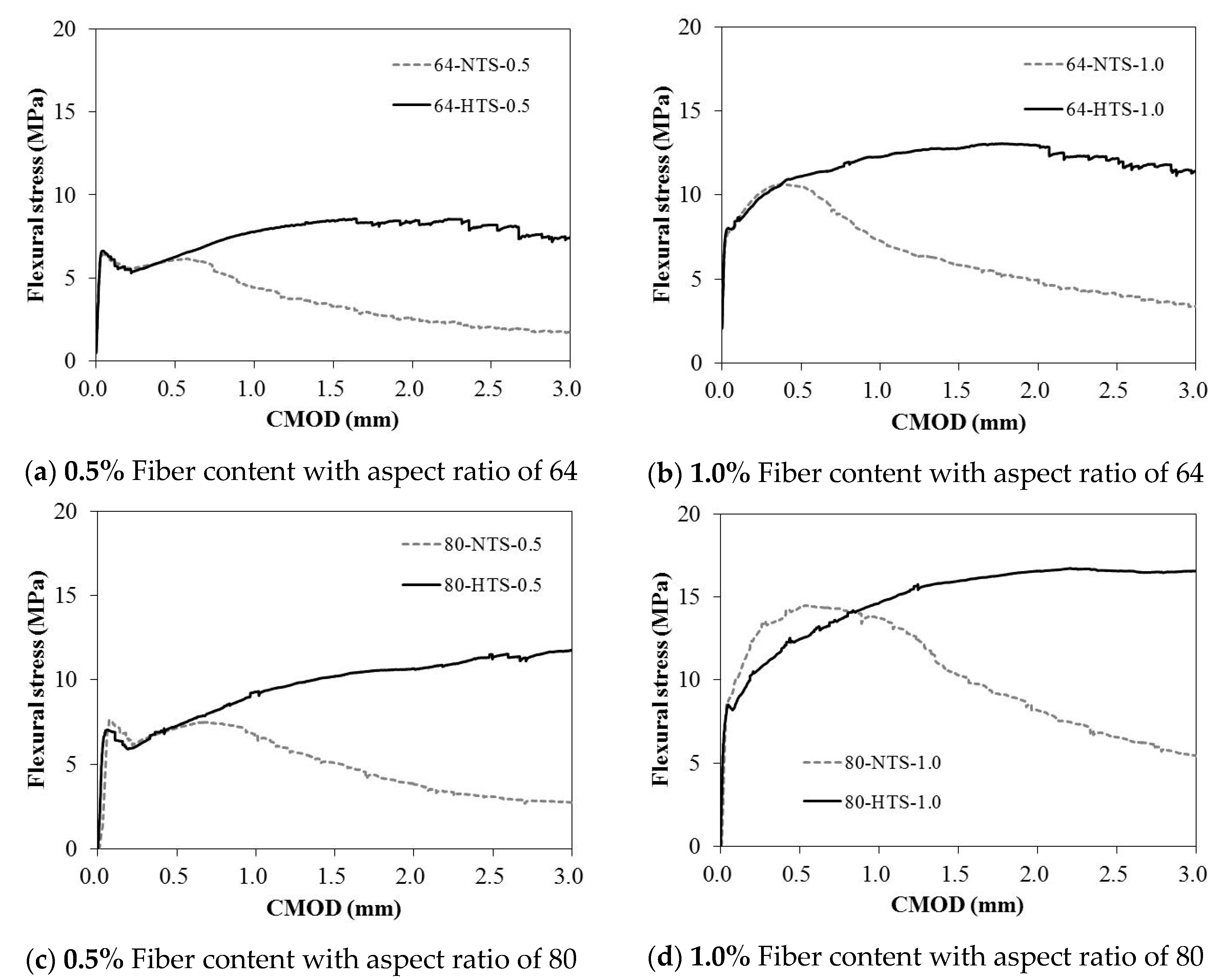

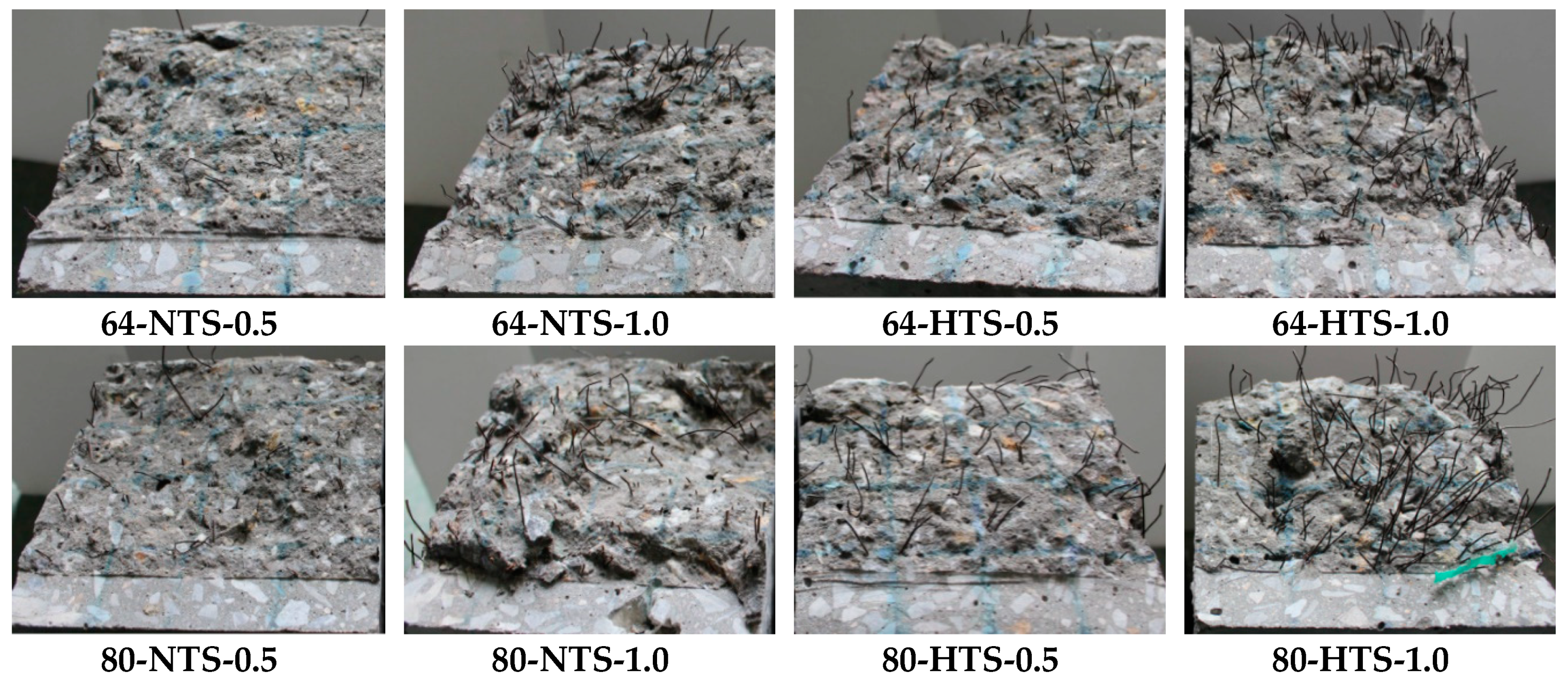
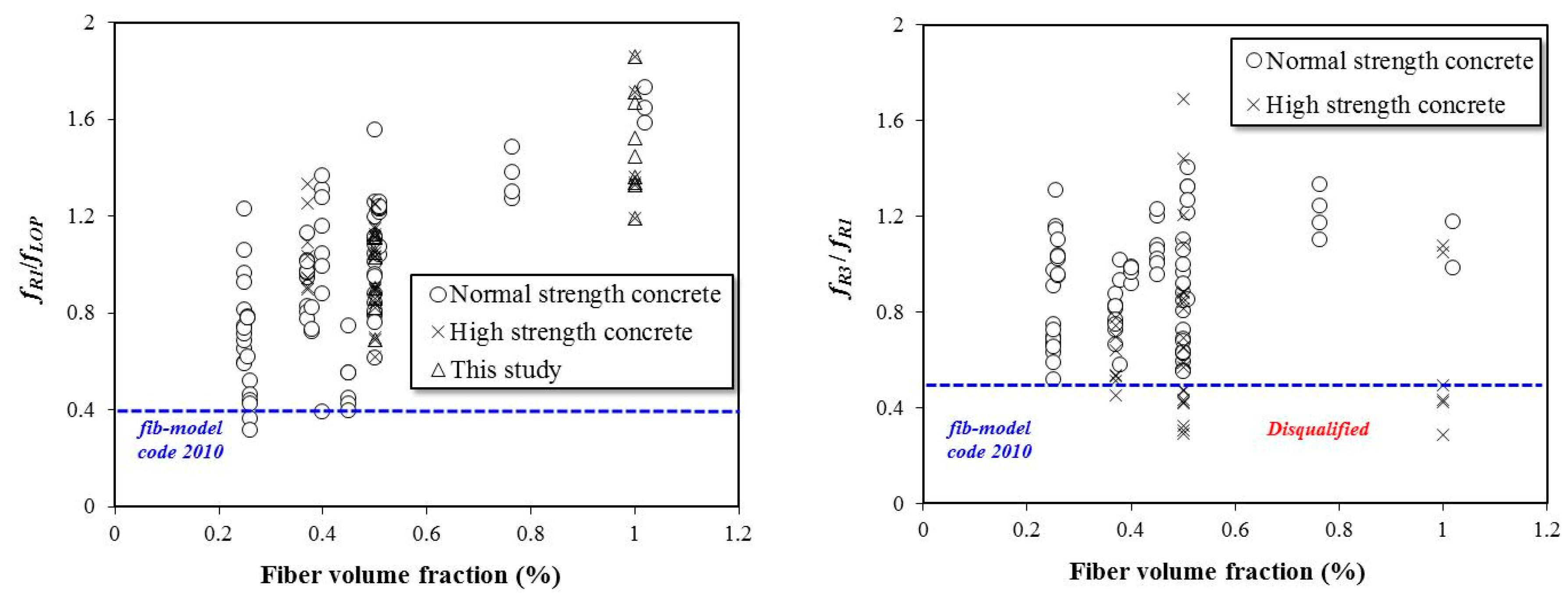
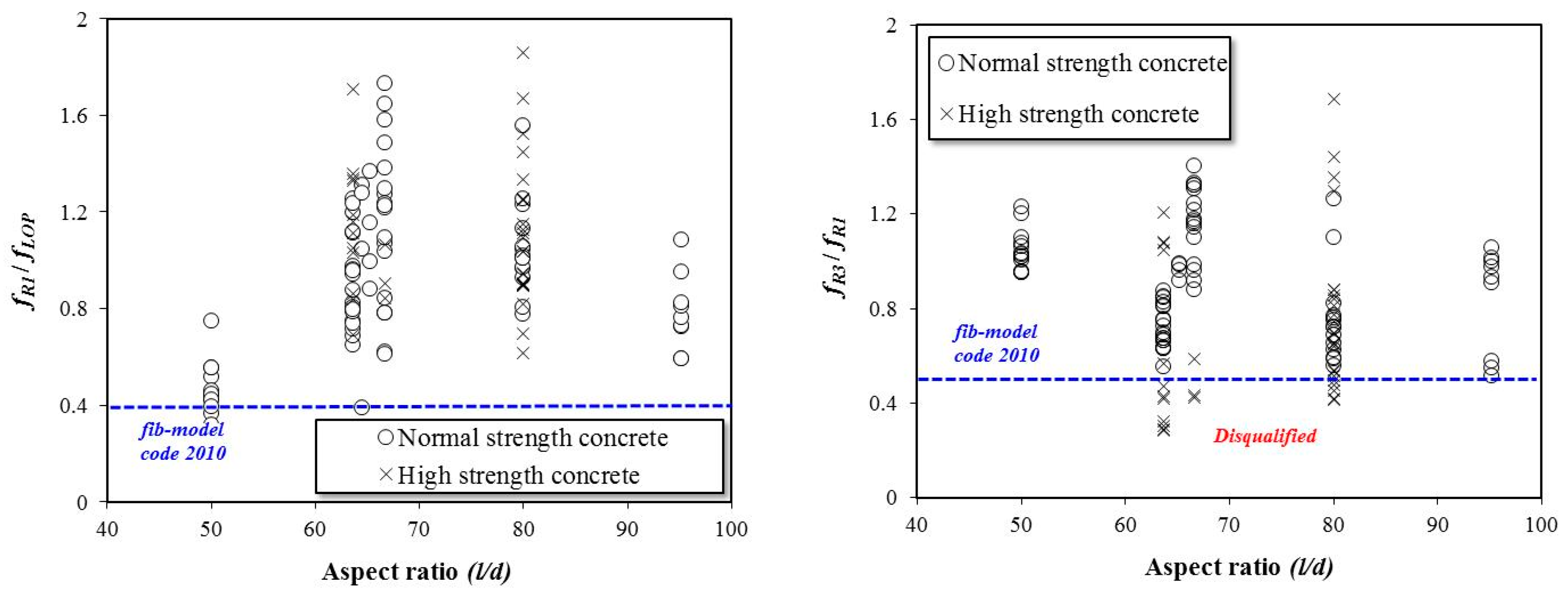
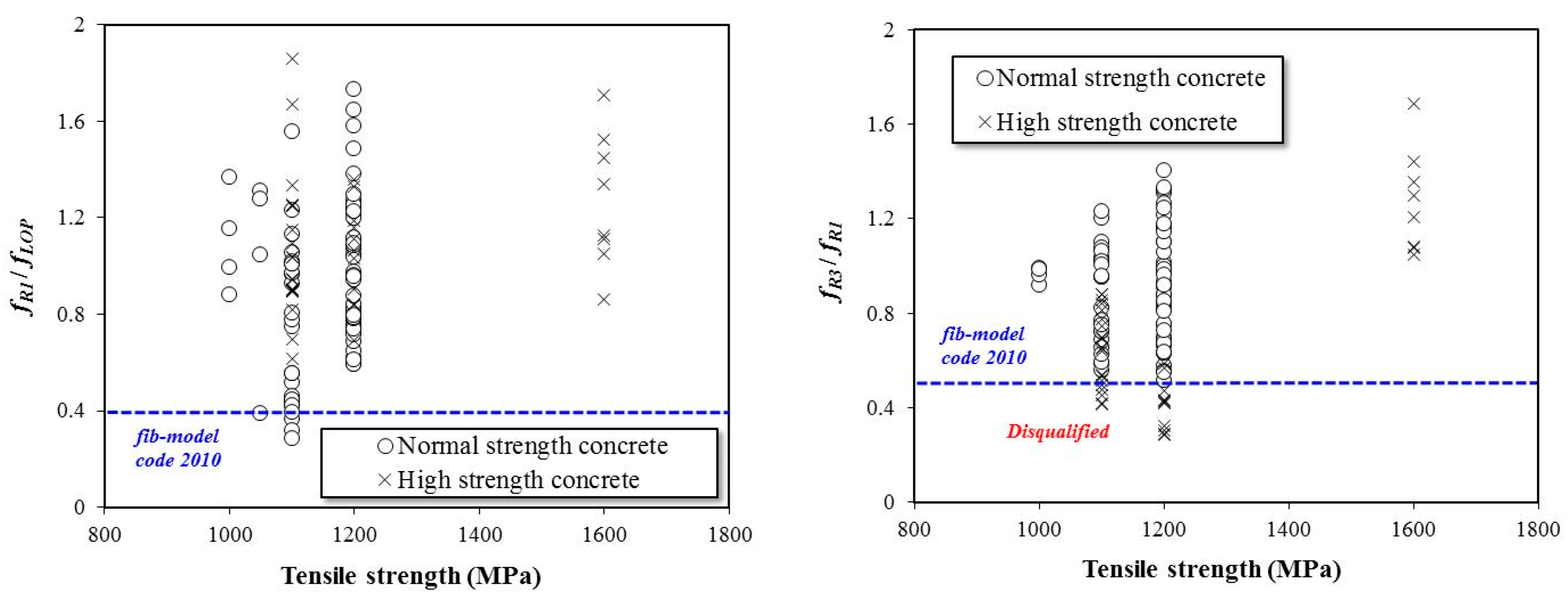
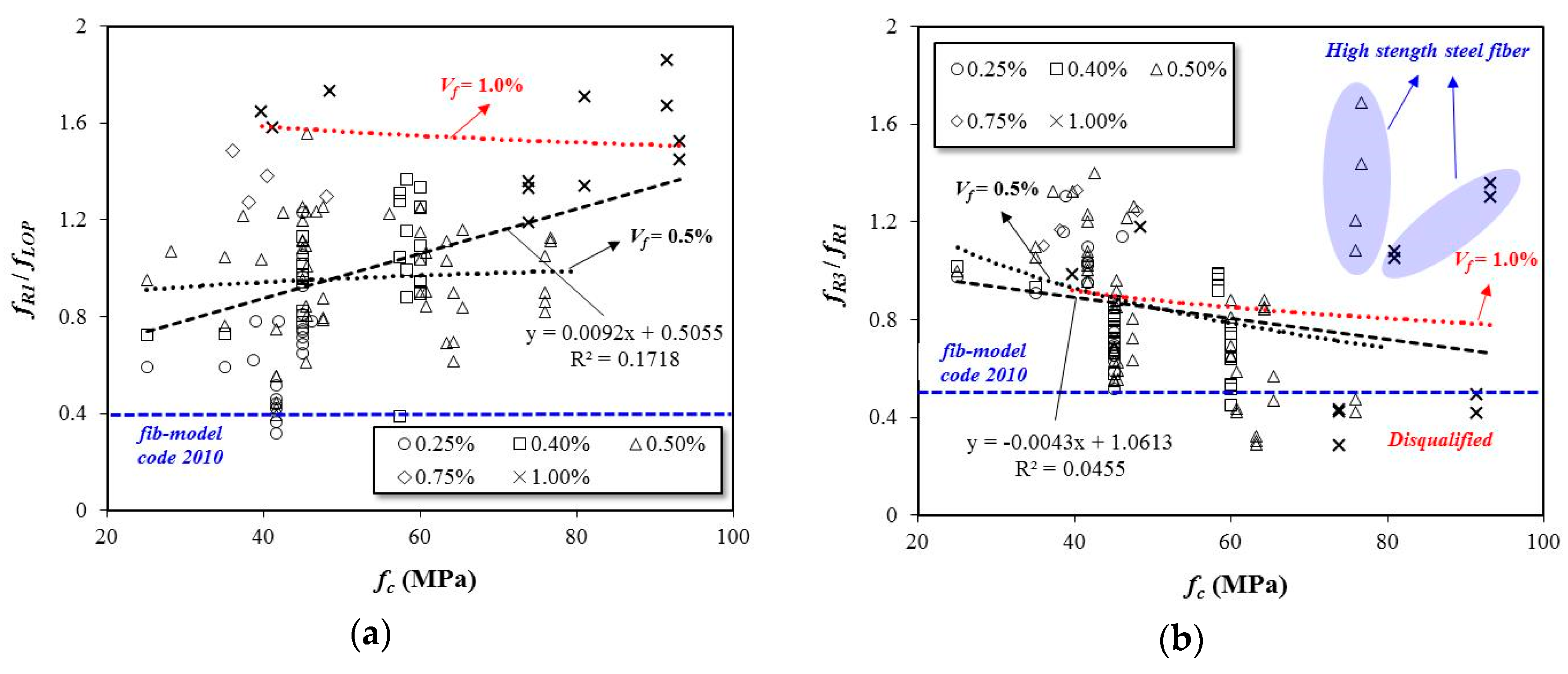
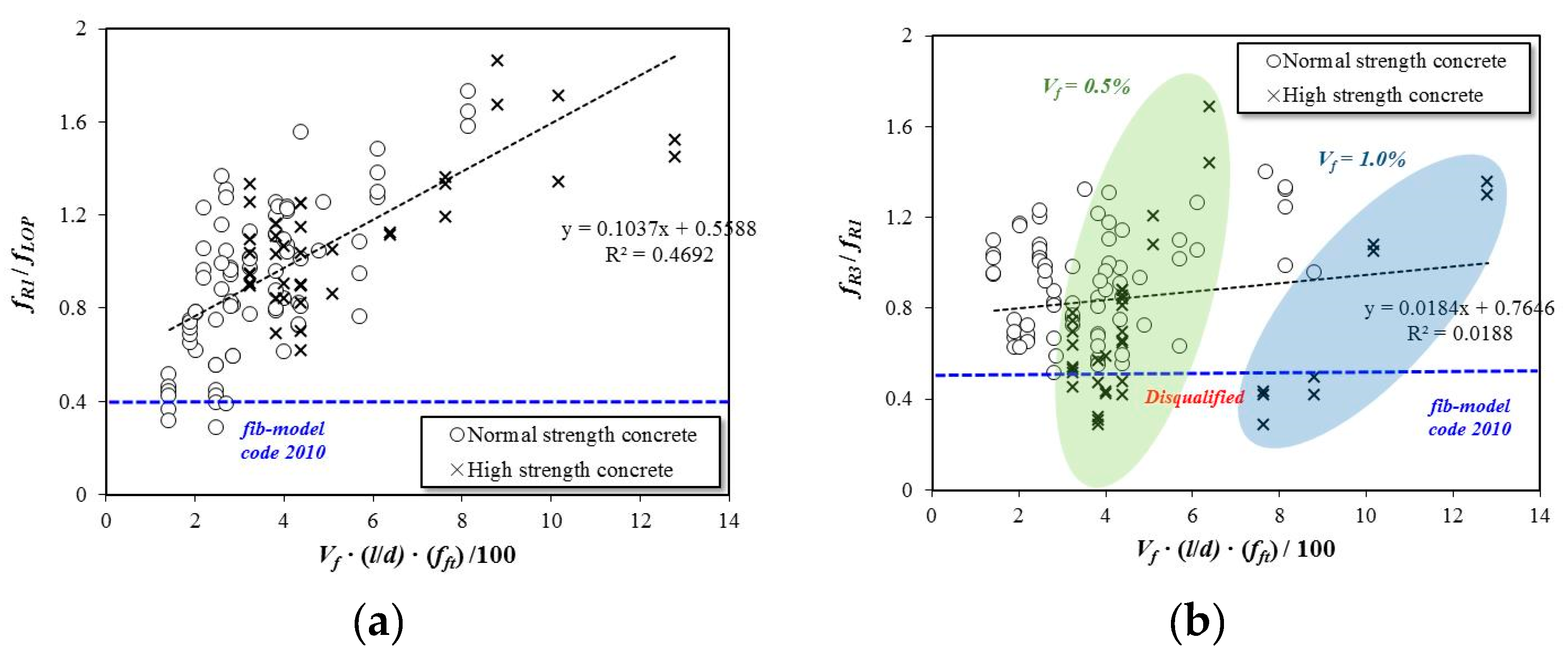
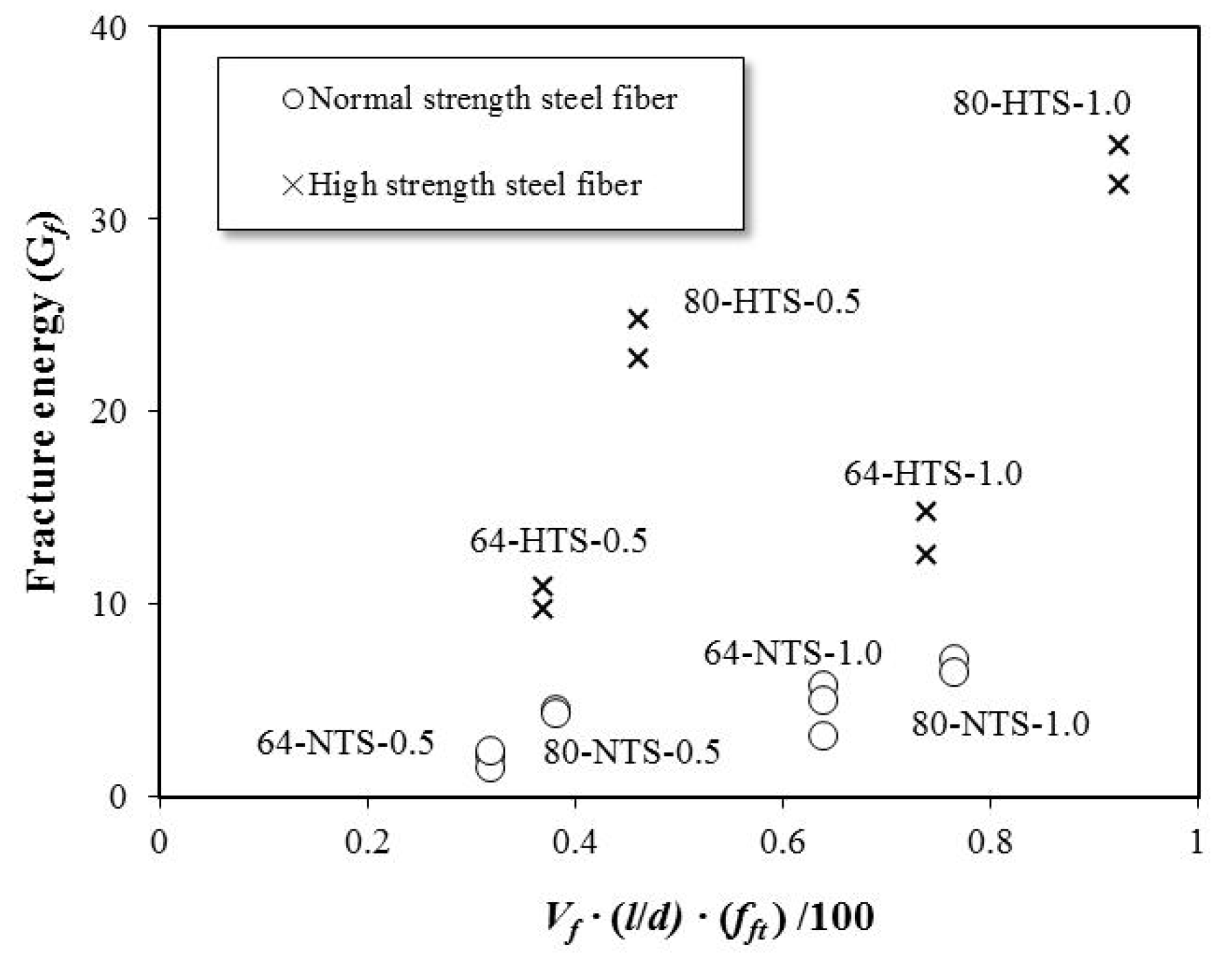
| fck (MPa) | W/B (%) | Air (%) | Unit Weight (kg/m3) | ||||||
|---|---|---|---|---|---|---|---|---|---|
| W | C | SF | FA | S | G | Steel Fiber | |||
| 80 | 25 | 4 | 165 | 462 | 66 | 132 | 643 | 813 | 0 |
| 39.3 | |||||||||
| 78.5 | |||||||||
| Specimen | fLOP | fR | fR1 | fR3 | fR1/fLOP | fR3/fR1 | Gf |
|---|---|---|---|---|---|---|---|
| (MPa) | (MPa) | (MPa) | (MPa) | (N/m) | |||
| CON | 7.02 | 7.02 | - | - | - | - | - |
| (±0.29) | (±0.29) | ||||||
| 64-NTS-0.5 | 6.43 | 6.87 | 6.07 | 2.05 | 0.94 | 0.34 | 1950.70 |
| (±1.30) | (±0.57) | (±3.64) | (±1.13) | (±0.18) | (±0.01) | (±370.87) | |
| 64-NTS-1.0 | 7.83 | 10.69 | 10.50 | 4.09 | 1.34 | 0.39 | 4651.73 |
| (±0.50) | (±0.28) | (±0.58) | (±2.18) | (±0.07) | (±0.07) | (±1088.41) | |
| 64-HTS-0.5 | 6.57 | 8.89 | 6.26 | 8.18 | 0.96 | 1.31 | 10,317.59 |
| (±0.30) | (±0.62) | (±1.56) | (±1.79) | (±0.10) | (±0.06) | (±618.37) | |
| 64-HTS-1.0 | 7.98 | 13.06 | 11.09 | 12.18 | 1.39 | 1.10 | 13,673.07 |
| (±2.18) | (±1.53) | (±3.82) | (±2.40) | (±0.19) | (±0.01) | (±1127.82) | |
| 80-NTS-0.5 | 7.86 | 8.20 | 7.13 | 3.12 | 0.88 | 0.44 | 4372.64 |
| (±0.16) | (±0.08) | (±1.22) | (±0.06) | (±0.04) | (±0.03) | (±74.61) | |
| 80-NTS-1.0 | 8.81 | 14.50 | 14.36 | 6.55 | 1.63 | 0.45 | 6755.17 |
| (±0.77) | (±0.49) | (±1.88) | (±2.63) | (±0.10) | (±0.04) | (±344.22) | |
| 80-HTS-0.5 | 7.00 | 11.85 | 7.27 | 11.30 | 1.04 | 1.56 | 23,765.02 |
| (±0.41) | (±0.41) | (±0.15) | (±0.61) | (±0.08) | (±0.12) | (±1041.55) | |
| 80-HTS-1.0 | 8.39 | 16.86 | 12.46 | 16.55 | 1.49 | 1.33 | 32,813.33 |
| (±0.30) | (±0.39) | (±0.13) | (±0.53) | (±0.04) | (±0.03) | (±994.72) |
© 2019 by the authors. Licensee MDPI, Basel, Switzerland. This article is an open access article distributed under the terms and conditions of the Creative Commons Attribution (CC BY) license (http://creativecommons.org/licenses/by/4.0/).
Share and Cite
Choi, W.-C.; Jung, K.-Y.; Jang, S.-J.; Yun, H.-D. The Influence of Steel Fiber Tensile Strengths and Aspect Ratios on the Fracture Properties of High-Strength Concrete. Materials 2019, 12, 2105. https://doi.org/10.3390/ma12132105
Choi W-C, Jung K-Y, Jang S-J, Yun H-D. The Influence of Steel Fiber Tensile Strengths and Aspect Ratios on the Fracture Properties of High-Strength Concrete. Materials. 2019; 12(13):2105. https://doi.org/10.3390/ma12132105
Chicago/Turabian StyleChoi, Won-Chang, Kwon-Young Jung, Seok-Joon Jang, and Hyun-Do Yun. 2019. "The Influence of Steel Fiber Tensile Strengths and Aspect Ratios on the Fracture Properties of High-Strength Concrete" Materials 12, no. 13: 2105. https://doi.org/10.3390/ma12132105
APA StyleChoi, W.-C., Jung, K.-Y., Jang, S.-J., & Yun, H.-D. (2019). The Influence of Steel Fiber Tensile Strengths and Aspect Ratios on the Fracture Properties of High-Strength Concrete. Materials, 12(13), 2105. https://doi.org/10.3390/ma12132105






